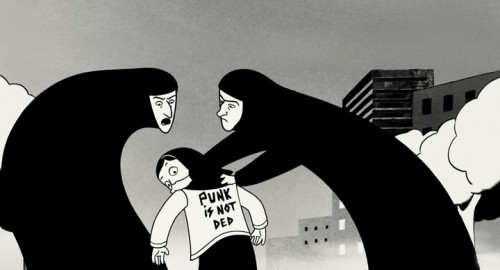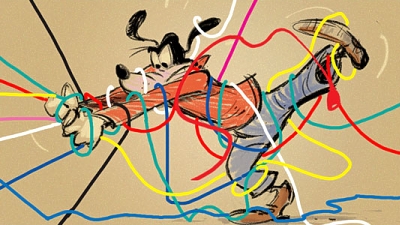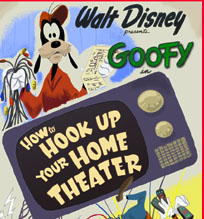
ESSAYS
My Journey to the Great White North
By Michael Barrier
The 2007 Ottawa International Animation Festival, held in Canada's capital city September 19-23, was only the second such festival that I've attended, after my first at Annecy, France, in 2004. Like Annecy, Ottawa is a lovely town, well suited to walking, which I did a lot of, especially since the festival venues were widely scattered. The festival's schedule was packed, too. I found that I was able to pare away screenings from my to-see list as the week went along, but a good bit of what was left was, to quote Spencer Tracy in Pat and Mike, cherce. Examples:
Main Events

° Persepolis, the festival jury's all-but-preordained choice as best feature, lived up to the hype. Based on Marjane Satrapi's graphic novel (which I haven't read) and co-directed in France by Satrapi and Vincent Paronnaud, Persepolis is an extraordinary film. That is so not just because it shows how well animation can handle serious and complex subject matter—in this case, the Iranian revolution and the oppressive rule of the ayatollahs—but also because it proves conclusively that an animated film can deploy sophisticated design as expressively as the best cartoons have always done with character animation.
Persepolis's design, of both characters and settings, is deceptively stark, but repeatedly I was startled and delighted by the ways the design was manipulated in the service of emotional depth. You'll be hearing a lot more about this film, and you should make every effort to see it. Visit Michael Sporn's Splog for more detailed comments, based on a screening at the New York Film Festival, and a nice selection of stills.
I didn't see one of the other two feature candidates, a Korean effort in which feces are used as currency, but I did see most of Free Jimmy, a British-Norwegian co-production. It's not only strikingly ugly but plays like a bizarre combination of Quentin Tarantino's Pulp Fiction and Ice Age. You can skip this one in the unlikely event it shows up in American theaters.
° A retrospective of Joanna Quinn's work, most of which I hadn't seen before, made me more fully aware of what a distinctive and likable screen presence this British animated filmmaker has. She's most familiar to American audiences through her Charmin commercials; the short films she has made independently have much the same graceful, feathery, hand-drawn look, but they also have, a little incongruously, the rowdy music-hall flavor of some of the most enjoyable British TV comedies (a resemblance heightened by the films' recurring characters, like the irrepressible Beryl). I would have welcomed subtitles, though, as a concession to the reality that whereas Canadians and Americans may speak something like a common language, many of our British cousins speak a different tongue entirely.
A Goofy Surprise
 The most pleasant surprise of the festival, for me, came at the end (not of the festival, but of my time there—I missed the last day): a new Walt Disney Animation Studios short starring Goofy, How to Hook Up Your Home Theater. It was the concluding item on a program called "International Showcase," made up mostly of European shorts of the kind—either gleefully or glumly perverse—I've come to associate with Annecy. I didn't expect much from the Disney short when I arrived at the festival, because the Disney people have not in recent years shown themselves adept in handling the studio's classic characters. An attempt to recreate the feeling of Jack Kinney's best "how to" shorts of the '40s seemed doomed to failure; even Kinney himself lost the knack after a relatively few successes.
The most pleasant surprise of the festival, for me, came at the end (not of the festival, but of my time there—I missed the last day): a new Walt Disney Animation Studios short starring Goofy, How to Hook Up Your Home Theater. It was the concluding item on a program called "International Showcase," made up mostly of European shorts of the kind—either gleefully or glumly perverse—I've come to associate with Annecy. I didn't expect much from the Disney short when I arrived at the festival, because the Disney people have not in recent years shown themselves adept in handling the studio's classic characters. An attempt to recreate the feeling of Jack Kinney's best "how to" shorts of the '40s seemed doomed to failure; even Kinney himself lost the knack after a relatively few successes.
I got interested, though, when I attended a program titled "Keeping It Old School: Looking like the 40s in a Digital Age." Marlon West, visual effects supervisor and artistic coordinator for the Goofy short, explained how the Disney people had studied the Kinney shorts with an eye toward achieving the same simplicity and directness on the screen, but without abandoning their digital tools. Home Theater's animation was hand-drawn, but for the most part on digital Cintiq tablets (Andreas Deja's scene was hand-drawn on paper and scanned in). The backgrounds, digitally created, were free of clutter. This struck me as tremendously encouraging. The impulse visible in most computer-animated films (Brad Bird's The Incredibles being the conspicuous exception) is toward ever-greater complexity, ever-greater detail, but for Home Theater to succeed the filmmakers had to move in the opposite direction, and they had understood that. I was happy, too, to see that the Kinney clips West showed were from some of the best of the "how to" cartoons, like Hockey Homicide and How to Play Football.
The news was even better when I saw the short itself. It was instantly clear that the film's directors, Kevin Deters and Stevie Wermers-Skelton, were after not just a simpler "look" but a stage clear of distractions for a torrent of gags. The gags are good ones, rooted not in stale cartoon conventions but in real life, the increasingly common experience of wrestling with complicated audio-video setups. And the gags are not all slam-bang stuff, either: one of my favorite moments is when Goofy, after being mesmerized by a huge TV screen, falls in love with one that's even more preposterously gigantic. The result is not a modern cartoon clothed in a tongue-in-cheek version of a much older style, like this recent commercial by Richard Bazley, but a modern cartoon that appropriates an older style for contemporary purposes.
As intelligently executed as How to Hook Up Your Home Theater is, I don't know that it's possible to make any predictions on the basis of this exhilarating success.
 The Kinney shorts were anomalies; thanks to Walt's inattention they were the least "Disney" of the shorts that emerged from his studio. At one point, Fred Quimby wanted to hire Kinney for the MGM cartoon studio's staff. Walt was able to veto that switch thanks to wartime restrictions, but Kinney would have been a natural fit alongside Tex Avery and Hanna and Barbera.
The Kinney shorts were anomalies; thanks to Walt's inattention they were the least "Disney" of the shorts that emerged from his studio. At one point, Fred Quimby wanted to hire Kinney for the MGM cartoon studio's staff. Walt was able to veto that switch thanks to wartime restrictions, but Kinney would have been a natural fit alongside Tex Avery and Hanna and Barbera.
The animation in Kinney's Goofy shorts, as wonderful as it was in the hands of an animator like John Sibley, wasn't "personality animation." As I wrote in Hollywood Cartoons: American Animation in Its Golden Age, Goofy in those shorts was "not much of a character at all. He filled the screen as player and spectator, in a range of sizes and shapes, but the dozens of Goofys were just extras in Kinney's comic spectacle. This was comedy of a kind that had no precedent in the Disney cartoons." It was because Home Theater demanded so little in the way of "personality" that it could be animated the way it was, the work spread out among some of Disney's best animators in bits and pieces. (Mark Henn, known for realistic female characters, is listed first in the credits. There's an interview by Christian Ziebarth with him and Andreas Deja at this link.)
Thanks to John Lasseter, other shorts are in the works at Disney, some "2D," others CGI. How well they'll turn out is anyone's guess. But at least we know now that today's Disney people are capable of much more than they were allowed to show in Chicken Little and Home on the Range.
A Few Disappointments
I'd looked forward to the four-program UPA retrospective, but I attended only the program devoted to the directors and introduced (on video) by Mark Kausler. The problem was that the shorts were shown as video projections of source material that was considerably less than pristine to begin with. My own VHS copies were superior in many instances; and I'd seen many of the cartoons in 35mm on other occasions, besides. So I scratched the remaining three programs.
Video projection was ubiquitous at the festival, I'm sure out of necessity; but what a difference 35mm made when it turned up in the "International Showcase" program, for How to Hook Up a Home Theater, and for the two features I saw. (If Free Jimmy had been worthy of its print quality and projection at the National Arts Center, it would have won the best-feature award going away.)
I wound up skipping all but the first of the five programs of shorts in competition, too. I'm a snob, I suppose, but I don't like most student films, and there were a lot of them not just in that first program but in the ones that followed. The non-student films weren't particularly ingratiating, either. I would have thought that screenings of Nick Cross' The Waif of Persephone, an interminable twelve and a half minutes of pseudo-Kricfalusi ugliness, were banned under the international agreements prohibiting torture. But evidently not.
I shared a panel on animation blogs with Jerry Beck (Cartoon Brew), Mark Mayerson (Mayerson on Animation), and Jeff Hasulo (Hydrocephalic Bunny), with Maral Mohammadian of the National Film Board as moderator. Ward Jenkins was supposed to be among the panelists, too, but he couldn't make it, unfortunately. Jerry and I have seen each other many times over the years; Mark and I last saw each other perhaps thirty years ago, when I hosted a screening for ASIFA in New York; Jeff and I had never met. I was happy to share a panel with all of them.
My memories of the panel are now blurrier than my memories of many of the films I saw, and the last I heard, plans were afoot to put the whole hour and a half online, as a podcast, so I won't struggle to reconstruct what the four of us said. But there were things that did stick in my mind. It was, for instance, very gratifying to hear both Mark and Jerry say that encountering Funnyworld back in the '70s had stimulated their own serious interest in animation.
I carried away two strong impressions from the panel.
One is that animation blogs are increasingly dominated by what I call "shop talk"—that is, they're put up by people who work in animation and use them as vehicles for exchanging pleasantries (mostly) with other animators and showing off their drawings. My other strong impression is that the realities of the animation business mean that most people are going to be very careful what they say on such blogs, so as not to offend present or possibly future employers. (Thus, I would guess, the fatuous compliments that some bloggers bestow on other bloggers. You never know when that "dude" might have a job to offer.)
What I see is a sort of closed loop—people in the business talking to other people in the business, but always with the understanding that what matters most, the meaningfulness of the work, isn't going to be discussed, unless the films involved are so old that no one who worked on them has any power over jobs (if they're even still alive). Otherwise, discussion is on a much more superficial level.
This is a different environment from the one in which I launched Funnyworld. I think there's real resentment now, not just from demagogues like John Kricfalusi but from people at studios like Disney, of "outsiders," unless they're groveling fanboys or essentially neutral conduits like Cartoon Brew. Which is to say, I think there's a growing number of people who question the very legitimacy of blogs like mine, and of the function I try to serve.
As selfish as it may sound for me to say so, I don't think that's a particularly healthy situation. There is, after all, no fundamental difference between the moviegoer who sees something like Home on the Range and says as he leaves the theater, "What a piece of ...," and the critic, like me, who tries to explain what it was he found wanting in that film. There's surely some value in knowing what people think of your work.
Or maybe not.
Incidentally, as the photo of the Rideau Canal and the Chateau Laurier hotel at the top of this page should tell you, the title of this piece is a joke. Ottawa was so warm during the festival that I wore bermuda shorts about 90 percent of the time. Global warming is for real, if Ottawa 2007 is any measure.
[Posted October 19, 2007]